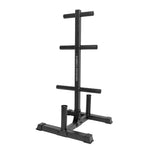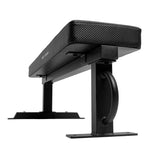Choosing the Best Barbell for You

The Olympic barbell is foundational to any serious home gym. Yet, contrary to what many think, not all barbells are created equal.
Choose the wrong one and you might face unnecessary challenges, from limited weight capacity to discomfort during lifts. The right bar will support your fitness goals, match your experience level, and provide a safe training environment for everyone in your household. Simply put, buying the right barbell is critical to setting yourself up for weightlifting success.
This article will guide you through the Olympic barbell selection process to ensure you get it right.

First Things First: Why Choose an Olympic Bar?
An Olympic barbell is seven feet long with 2-inch diameter revolving sleeves that accommodate weight plates with a 2-inch hole in their center. They’re more expensive than the thinner, shorter bars that take one-inch diameter plates. So, why go for that extra expense?
Here are four reasons:
-
Higher Weight Capacity: Olympic barbells are designed to hold more weight than standard bars, making them suitable for heavy lifting and progressive overload training.
-
Durability: These bars are constructed with higher-quality materials and superior craftsmanship, ensuring durability and longevity even with regular use.
-
Enhanced Performance: Olympic bars feature specific design elements like whip and rotation, which optimize performance during lifting exercises, providing a smoother and more effective workout experience.
-
Standardized Size: Olympic barbells are standardized in size, allowing compatibility with all 2-inch Olympic weights and accessories on the market. This consistency ensures a seamless workout experience and easy integration with existing gym equipment.

Key Considerations When Choosing an Olympic Barbell
To the uninitiated, Olympic barbells are pretty much all alike. But they’re not. Before you start looking for your next bar, it’s essential to understand the nuances so you know what to look for.
Here’s an overview of what you need to know so you can buy with confidence that you're making the right choice for your home gym:
1. What level of weightlifting experience do you have?
Your weightlifting experience level is the first thing to consider when choosing an Olympic barbell for your home gym setup.
Beginners
Beginners (less than six months of weightlifting experience) should choose a slightly shorter and lighter Olympic barbell. This allows you to practice proper form with a slightly more manageable piece of equipment, giving you room to learn the basics before moving up to a full-sized Olympic Barbell.

Typical Olympic bars weigh 20 kilograms (though often called a “45-pound bar,” they actually weigh 20 kg, or 44 lbs) and measure 86.6 inches long (though called a seven foot bar, regulation barbells are about 7.2 feet long).
However, our Barbell 1000 is 11 pounds lighter and 8 inches shorter at 33 pounds and 78 inches. Forged from the same steel as our Barbell 1500 and equipped with the same needle bearings and brass bushings sleeves, the Barbell 1000 provides a compelling value option for anyone looking for a starter Olympic barbell or anyone trying to squeeze a gym setup into a tight space.
Intermediate/Advanced
If you have recent or past weightlifting experience, you’re probably best off starting off with a full-sized 45-pound Olympic barbell such as our Barbell 1500 or Barbell 2000. Continue reading to learn how to choose between these two and the many other barbell options.

2. Which lifts will you use the bar to do?
The type of lifts you plan to do is an important factor when choosing an Olympic barbell. Let’s consider the options:
The Big Three
If you plan to focus your strength training routine on the core three weightlifting movements (squats, deadlifts, and bench presses), you’ll want to choose a sturdy Olympic barbell with medium knurling that doesn’t have too much whip and sleeve rotation.
Powerlifting barbells (commonly called "Power Bars") are designed for people focusing on these core lifts, by combining a more textured knurl for a firm grip, a stiffer bar to accommodate the big-three, and traditional brass bushings which provide a reliable and consistent spin for just the right amount of support for these lifts.

The Barbell 2000 fits the bill precisely as our own Powerlifting Bar. This barbell provides a more robust and stiffer forged steel bar vs. our popular Barbell 1500, with rougher textured knurling, brass bushings, and powerlifting knurl marks on the shaft.
Explaining Barbell Whip and RotationWhip refers to the flexibility or bendiness of the barbell when loaded with weight. A bar with more whip can store kinetic energy and provide a rebound effect during lifts like the clean and snatch, enhancing performance. Rotation refers to the sleeves' ability (the ends of the barbell where the weight plates go) to spin independently from the shaft. Smooth rotation allows smoother transitions during lifts, reducing stress on the wrists and improving overall technique. |

General Purpose Lifts
If you plan to focus on a wide range of movements, which may or may not include Olympic lifts like Cleans and Snatches, you’ll need to pay close attention to the bar’s stiffness, knurl, spin, and knurl marks.

With smooth spin to help the plates rotate and reduce the risk of injury, ideal whip to create momentum through the beginning of your lift, and dual knurl marks on a lightly knurled steel shaft, the Barbell 1500 is the ultimate all-purpose barbell designed to provide the best experience for the widest range of lifters and lifts.
Stiffness/Whip—You’ll want a bar with some slight flexibility as the load is accelerated off the floor/rack to allow optimal weight transfer as the weight moves through the most explosive portion of the lift.
Knurl—Look for a bar with a light to medium knurl, but this is mostly preference-based. Some people like the firm grip of a more textured knurl, while others prefer a more comfortable experience and use hand chalk to increase friction as needed.

What You Need to Know About KnurlingThe knurling on a barbell refers to the machine grooves in the gripping area of the bar. It is designed to make maintaining your hold on the bar easier. Three main knurling pattern variations are colloquially known as ‘hill,’ ‘volcano,’ and ‘mountain.’ Hill knurling is the smoothest of the three, with the mountain being the most aggressive. The deeper the knurling grooves, the more grip support it will provide. However, some may find a more aggressively knurled bar too uncomfortable on the palms. Volcano knurling provides a happy medium between being too smooth and too aggressive. It delivers more hand contact points to enhance grip without requiring overly sharp grooves. |
Knurl Marks - Standardized hand positions are indicated on the barbell with ‘knurl marks’ - thin, smooth rings with no knurling. There are two standard hand positions, one for Powerlifting and one for Olympic Lifts. A general-purpose bar should have both Powerlifting and Olympic lifting knurl marks.

Spin - A smooth and responsive spin is crucial for an all-purpose and Olympic lifting barbell to ensure your wrists and joints can freely rotate throughout the range of motion.
Isolation and Light Lifting
Suppose you plan on primarily doing isolation movements such as military presses, curls, and rows or never going past a pair of 45s on each side (135 pounds total). In that case, you should opt for a shorter, lighter, more maneuverable bar.
The Barbell 1000 is perfect for light lifters and beginners because its smaller size makes it easier to handle and store. The bar is rated for up to 1,000 pounds and recommended for anything up to 400 pounds—most people will never need anything more.
You might also consider opting for one or two specialty bars, like a Curl Bar, a Hex Trap Bar, or even a pair of our Olympic Loadable Dumbbells.

3. How much weight does the bar need to handle?
The first two factors may have already sealed your decision, but before finalizing, you must consider the amount of weight you plan on lifting.
Several metrics are used to describe the load that a bar can handle such as (such as tensile strength), but to simplify things, most manufacturers will identify the maximum weight rating for their barbells.
Be sure to leave plenty of room between the amount of weight the bar can handle and the amount of weight that you plan to lift. For example, if you buy a bar with a weight rating of 1000 pounds, you don’t want to load more than 800 pounds of weight on that bar.
You never know how much strength you’ll gain, and only highly trained professionals in a structured environment should ever consider pushing equipment to the limit when dealing with this kind of weight.
We offer two ratings for each of our Olympic bars:
-
Maximum Static Load
-
Maximum Dynamic Load
Each of these numbers have been verified in our Boca Raton gym to provide a real-world rating for our products. The Static Load refers to the amount of weight the bar can handle without permanent visible bend or deformation. The Dynamic Load refers to the maximum amount of weight that has actually been lifted by one of our athletes.
4. Finishing Touch
As a final consideration, it’s essential to consider the finish of your new bar. Not only will this influence the feel of the bar in your hands, but the finish you choose also influences how well your bar holds up to the elements and the rigors of your workouts.
-
Bare steel offers the best feel and grip as a low-cost alternative. However, it offers zero corrosion resistance and requires maintenance after each use, so it is not a popular option.
-
Coating options provide corrosion resistance and improved durability for a tradeoff in the way the bar feels in your hand. The most popular coating options are Zinc, Chrome, and Cerakote.
-
Chrome coating offers minimal corrosion resistance and a relatively low impact on grip feel. This is a value-based alternative that provides minimum protection.
-
Barbells with Cerakote finish have the highest corrosion resistance but at the expense of a grip many cannot tolerate. The coating is known to chip and flake with visible blemishes over time.
-
Barbells with a zinc finish (like ours) offer nearly the same high corrosion resistance as cerakote with a natural grip feel. This makes it a preferred protective coating for fitness equipment. Suitable for use in various environments, from humid gyms to outdoor training areas, Zinc is less prone to rust and wear while making a sharp addition to your setup.
Final Thoughts
Whether you're a beginner or an experienced lifter, choosing the right Olympic barbell can make a world of difference in your workouts.
Now that you know the most important factors to consider when picking out the right Olympic bar for your fitness goals, head over to our Bars Collection to see how our bars stack up with your needs. With our carefully curated selection of bars, we’re sure you’ll find just what you’re looking for.
Still need help deciding which barbell is right for you? Head on over to the Bars Collection page for a quiz that might help you to decide.
Happy lifting!


